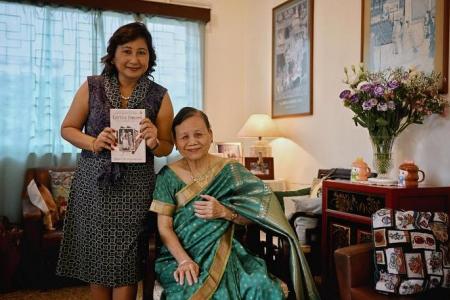Inspired by her mother’s birth story, she wrote a book about inter-racial adoptions in S’pore
Mrs Jane Devasahayam, 85, was just a four-day-old baby when she was given up for adoption by a Chinese widower.
Her biological mother had died giving birth to her.
Born to a Chinese farmer and his wife in Johor, she said: “It’s like I brought bad luck to my family... there was also no one to look after me.”
It did not help that she was born in the Year of the Tiger, and some Chinese believe that girls born under this zodiac sign have fierce temperaments and will bring bad luck to their family, she said.
In primary school, her teachers told her she is Chinese, and not Indian.
She said: “I went to ask my (adoptive) mum why I was so fair. She said jokingly that I fell into a pot of milk as a baby and that is why I’m so fair.”
Her adoptive mother, who worked as a mid-wife, later told her the truth that she was adopted. Her adoptive parents have a biological son who is nine years older than her.
Mrs Devasahayam said she did not mind the fact that she was adopted, adding that her adoptive mother loved her dearly.
Decades later, her origin story piqued her own daughter’s interest in the practice of inter-racial adoptions, which was common in the past.
Her daughter, Dr Theresa Devasahayam, a part-time sociology lecturer at the Singapore University of Social Sciences, wrote a book on the topic which was published in December 2023.
The book, titled Little Drops: Cherished Children Of Singapore’s Past, tells the stories of 15 people, who are mostly Chinese girls adopted by a family of another race, in pre-independence Singapore.
They include lawyer and women’s rights activist Anamah Tan, who is a founder member of the Singapore Council of Women’s Organisations. She was also a member of the United Nations’ Committee on the Elimination of Discrimination against Women.
Dr Tan, who turns 84 in 2024, was born into a Chinese family, but she was adopted by a Ceylonese Tamil family.
In 2020, Dr Devasahayam published a journal article on children who were adopted by Indian families in pre-independent Singapore and Malaysia. These children were often girls born to Chinese families.
Dr Devasahayam said adoptions were common in Singapore before the Republic became independent in 1965. But there was a lack of data, as most children were adopted without any legal documentation or arrangement.
She said: “Inter-racial adoptions were common enough that people didn’t bat an eyelid. The older generation of Singaporeans always knew about this trend, but the younger generation is completely clueless about it.
“So I feel it needs to be documented and put out there.”
Children were given up for adoption as their parents often had too many children whom they could not afford to raise, said Dr Devasahayam.
There was also a strong preference for sons back then, and it was often the girls who were given away, she added.
Some of her interviewees told her they were given to a family of another race as astrologers advised their birth parents to do so, for example, to avoid bringing misfortune to the family.
She added: “And the Chinese couples implicitly understand that Malay and Indians love children, and they would treat their child well.”
But the child is often not told about the adoption, as there is a real fear that they may run back to their birth parents if they know the truth, she said.
Her own mother, Mrs Devasahayam, has always identified herself as an Indian woman, despite her Chinese roots. This is because of her Indian upbringing, Mrs Devasahayam said.
Mrs Devasahayam speaks English, Malay and Tamil, but not Chinese – which often puzzles people.
About 50 years ago, she went to her hometown in Malaysia to try to find her biological family, but to no avail.
She said: “I don’t feel angry with my birth parents for giving me away. I have had a happy childhood.”
Get The New Paper on your phone with the free TNP app. Download from the Apple App Store or Google Play Store now


